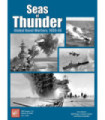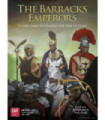- Français , Anglais , Allemand
Frais de port offerts à partir de 80€ (France métropolitaine)
Global Naval War 1939-45
World War 2 was the largest and most violent extended naval war in history. From September 1939 until the surrender of Japan, the high seas were a global battle zone filled with mighty battleships, nimble cruisers, silent hunters, and flat-tops bristling with planes. Before our eyes, we witnessed the changing of warfare on the high seas as the thunderous old guard fell to air power and submarines Raiders prowled the open waters and the carrier showed its true diversity and adaptability. Seas of Thunder not only allows players to re-create the Atlantic or Pacific theaters of the war but to see how challenging the entire picture was for their leaders. How do you protect a globe from German raiders? How desperate was it for Britain when France fell and they were left to fight Germany and Italy alone on the high seas? What is the right balance for the Soviet fleet split between for distinct fronts (Baltic, Black Sea, Arctic, and Pacific)? If the Mediterranean force weakens for the allies, where to they draw ships. from? Does Japan strike quickly or play for attrition when they arrive on the halfway point? Will America fight in two fronts, three, or four? In Seas of Thunder, players will experience the tension of too much sea to cover with too few ships, the frustration of being caught unprepared, or the intensity of a vital stand contesting a high-value sea area. Victory is neither sudden nor guaranteed. In each battle, a flight of Catalinas, the lack of ASW, the improper distribution of air power, or even a missing minesweeper could be the difference between success or failure. Seas of Thunder is every bit a full-force strategic-level representation of the conflict on the high seas during World War 2. Players have to manage a global disposition of their warships with frequently too much ocean to cover and not nearly enough ships to cover it. Each nation has access to the historical ships that sailed in the conflict. Each country's fleets have advantages and disadvantages that are unique to them. Germany: Small surface fleet but complemented with an ever-expanding force of Submarines. Reliance on Armed Merchant Raiders that can strike all over the globe. Additionally their use of Neutral ports allows them great flexibility in setting up their plans and forcing the Allies to respect the entire battlefield. Great Britain: Superior warships in quantity but not as new as the German Fleet in general. All of the ships operationally tied to a global network of bases. Care and forethought is required at the start of each game regarding their deployment , as re-deployment will be challenging. France: Quality Ships that will be bounced from side-to-side over the course of a game. Their disadvantage is moving first and opening themselves up to being savaged each time they leave port. Italy: Has strong ships and local superiority in the Mediterranean. A lack of wartime building means that Italian losses are not replenished at the rate the Allies are, so each loss feels more permanent and damaging. Soviet Union: Respectable ships and submarines are countered by the fact that they are forced into restrictive fights on three or four fronts (Baltic Sea, Arctic Ocean, Black Sea, and Pacific Ocean). Each of these fights are usually balanced agains the Russians, but they must at least threaten on all of them to alleviate pressure on the other Allies. Japan: Begins the war with a huge fleet of varying and unique ships. They are easily a match at first for any opponents. As the war progresses, the USA and UK begin to rise up and challenge them for dominance. The Japanese player has to understand their limits and not over-reach with what feels like unstoppable power. USA: Starts off the game with plenty of ships and plenty of holes to fill. The Pacific is brutal with Japan processing so much power. But the Mediterranean needs shored up, not to mention the Atlantic war against the U-boats. Over-reach will be the watchword for the day as the American commander. As the game progresses, the power shifts in your favor, as do the responsibilities. Objectives and Scoring At its heart, Seas of Thunder is a large area control game where the Allies score low numbers of points for control and the Axis score higher per area. Controlling 6 Areas for the Allies may not be as valuable as scoring 1 area for the Axis. The Axis player seeks to win key zones, and the Allied player must make them pay dearly for them. The game is divided up into 7 smaller scenarios or campaigns that can be played 'as-is or combined to fight a portion of the war all they way up to the entire campaign. Points are scored each turn for the following: Variable points per Sea Zone controlledEach Convoy of the opponent SunkEach Enemy Warship SunkEach Land-Based Air Unit not used (and thus allowed to participate in the ground war or strategic bombing)


















